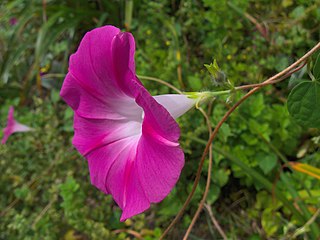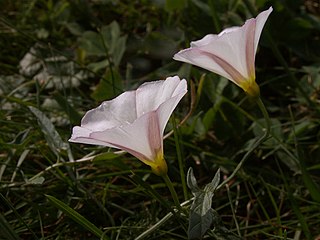Convolvulaceae
Ipomoea hederacea
 Morning Glory (Ipomoea purpurea).
An introduced ornamental that has become quite weedy,
especially in the city of Pittsburgh, where it covers
banks and winds through vacant lots with gay abandon.
Flowers large and showy; trumpet-shaped, like an old
phonograph horn. They come in several colors, from the
deepest velvety purple to bright pink and pale blue.
Leaves are distinctively heart-shaped. The vines twine
around everything including other morning glories.
Morning Glory (Ipomoea purpurea).
An introduced ornamental that has become quite weedy,
especially in the city of Pittsburgh, where it covers
banks and winds through vacant lots with gay abandon.
Flowers large and showy; trumpet-shaped, like an old
phonograph horn. They come in several colors, from the
deepest velvety purple to bright pink and pale blue.
Leaves are distinctively heart-shaped. The vines twine
around everything including other morning glories.
 Wild Potato Vine (Ipomoea pandurata).
A spectacular wild morning glory closely related to
the sweet potato. It grows a similar starchy root that
was an important food source for American Indians.
Like many other members of the family Convolvulaceae,
it really loves a chain-link fence.
Wild Potato Vine (Ipomoea pandurata).
A spectacular wild morning glory closely related to
the sweet potato. It grows a similar starchy root that
was an important food source for American Indians.
Like many other members of the family Convolvulaceae,
it really loves a chain-link fence.
Convolvulus spothamaeus
 Field Bindweed (Convolvulus
arvensis) is a more delicate, and much
rarer, wild morning glory than its ubiquitous cousin
Hedge Bindweed (Calystegia sepium, formerly Convolvulus
sepium). Note the small arrowhead-shaped
leaves.
Field Bindweed (Convolvulus
arvensis) is a more delicate, and much
rarer, wild morning glory than its ubiquitous cousin
Hedge Bindweed (Calystegia sepium, formerly Convolvulus
sepium). Note the small arrowhead-shaped
leaves.
 Hedge Bindweed (Calystegia sepium).
Also called Wild Morning Glory. Hedge Bindweeds do
indeed love hedges, but they really come into their
own on a chain-link fence. Most often the flowers are
white, but sometimes we see a glorious bicolor like
this one, which in size and color rivals the
cultivated Morning Glory. They have a long blooming
season, from the beginning of summer into the fall.
Hedge Bindweed (Calystegia sepium).
Also called Wild Morning Glory. Hedge Bindweeds do
indeed love hedges, but they really come into their
own on a chain-link fence. Most often the flowers are
white, but sometimes we see a glorious bicolor like
this one, which in size and color rivals the
cultivated Morning Glory. They have a long blooming
season, from the beginning of summer into the fall.
 Dodder (Cuscuta gronovii). A
curious parasitic member of the Morning-Glory family.
Dodder has no green coloring of its own because it has
no chlorophyll; instead, a seedling must, within a few
days of sprouting, attach itself to a suitable host
plant, and begin to rob it of its sap. There are many
species of Dodder around the world, but this one is
(as far as we know) the only one found in the
Pittsburgh area, which makes it hard to misidentify.
The stringy orange stems and the unearthly waxy flower
clusters are unique
Dodder (Cuscuta gronovii). A
curious parasitic member of the Morning-Glory family.
Dodder has no green coloring of its own because it has
no chlorophyll; instead, a seedling must, within a few
days of sprouting, attach itself to a suitable host
plant, and begin to rob it of its sap. There are many
species of Dodder around the world, but this one is
(as far as we know) the only one found in the
Pittsburgh area, which makes it hard to misidentify.
The stringy orange stems and the unearthly waxy flower
clusters are unique
 Morning Glory (Ipomoea purpurea).
An introduced ornamental that has become quite weedy,
especially in the city of Pittsburgh, where it covers
banks and winds through vacant lots with gay abandon.
Flowers large and showy; trumpet-shaped, like an old
phonograph horn. They come in several colors, from the
deepest velvety purple to bright pink and pale blue.
Leaves are distinctively heart-shaped. The vines twine
around everything including other morning glories.
Morning Glory (Ipomoea purpurea).
An introduced ornamental that has become quite weedy,
especially in the city of Pittsburgh, where it covers
banks and winds through vacant lots with gay abandon.
Flowers large and showy; trumpet-shaped, like an old
phonograph horn. They come in several colors, from the
deepest velvety purple to bright pink and pale blue.
Leaves are distinctively heart-shaped. The vines twine
around everything including other morning glories. Wild Potato Vine (Ipomoea pandurata)
Wild Potato Vine (Ipomoea pandurata) Field Bindweed (Convolvulus
arvensis)
Field Bindweed (Convolvulus
arvensis) Hedge Bindweed (Calystegia sepium)
Hedge Bindweed (Calystegia sepium) Dodder (Cuscuta gronovii)
Dodder (Cuscuta gronovii)